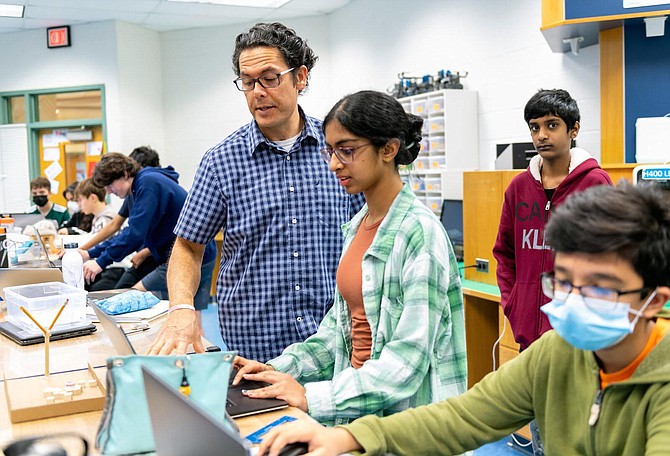Eighth-grader Rishab Naduri made a brace to help people with spinal cord injury inspired by his father’s back pain woes. His classmate Aasritha Duriseti made a specialized bottle cap opener after watching her grandmother struggle to open things on her own. And Roman Moreno-Hines made a “third thumb” that he hopes will help people with arthritis hold objects longer after noticing his grandfather’s difficulty hanging onto coffee mugs.
It’s all part of an “Engineering With Empathy” unit created by Rachel Carson Middle School instructor Mark Bolt for students in his Engineering 3 elective course.
“The overarching goal of this project is for my students to understand that empathy is an important component of engineering,” Bolt says. “Engineers need to understand their users’ needs, and put themselves in the users’ shoes, in order to then build an effective solution.”
Bolt challenged his students to start the project by researching various disabilities and the obstacles individuals must overcome to perform daily tasks. Then he had students construct an adaptive device, have classmates test it and give feedback that can be used to improve the item.
“Throughout the project, students follow the Engineering Design Cycle and document their work showing the evolution of their adaptive device from prototype to finished project,” Bolt said.
Eighth-grader Michael Kuwashima did just that with his “book blinds,” which are designed to assist people with dyslexia as they process written information. The blinds, made of folded paper that the user can move up and down on a page, can be used to isolate words by the reader.
“Fewer words means less to focus on so people will hopefully have an easier time reading,” Michael says, adding he started the project by asking a good friend with dyslexia to have an “in-depth talk” with him about what life is like with the disorder. “The biggest challenge he mentioned is that when you’re kind of tired, it is hard to focus anyways and words can get jumbled up.”
Kuwashima’s classmate Arjun Garg created a “dressing stick” to help people with limited mobility put on clothes more easily. The device has four hooks that can be utilized to do things like grab the arm holes of a shirt, so a person doesn’t have to twist around as much while getting dressed.
“I wanted to create something that would reduce pain and make life easier for people,” Arjun said. “I am interested in the medical field and this type of bioengineering is exactly what I want to do: make things that improve the lives of people, build devices that benefit patients and help doctors and nurses at the same time.”
Students noted the difference between solving problems in the classroom to benefit others and fun projects they’d previously undertaken, like work on model rockets and LED light stands.
“I loved the real world element,” said Rishab Nanduri, who made the back brace with velcro straps, chipboard, and fabric that he hopes would help people like his father on a daily basis.
Carson Middle School Principal Gordon Stokes agreed.
“So often our teachers in all classes are trying to connect their projects to real world applications and this unit did exactly that,” Stokes said. “Our students took the principles they’ve learned in the classroom, applied it in the real world and helped people in need. I think everything they’ve developed could be used right now to assist others. That is the hallmark of really good learning and I’m very proud of Mr. Bolt and his students for making it happen.”
